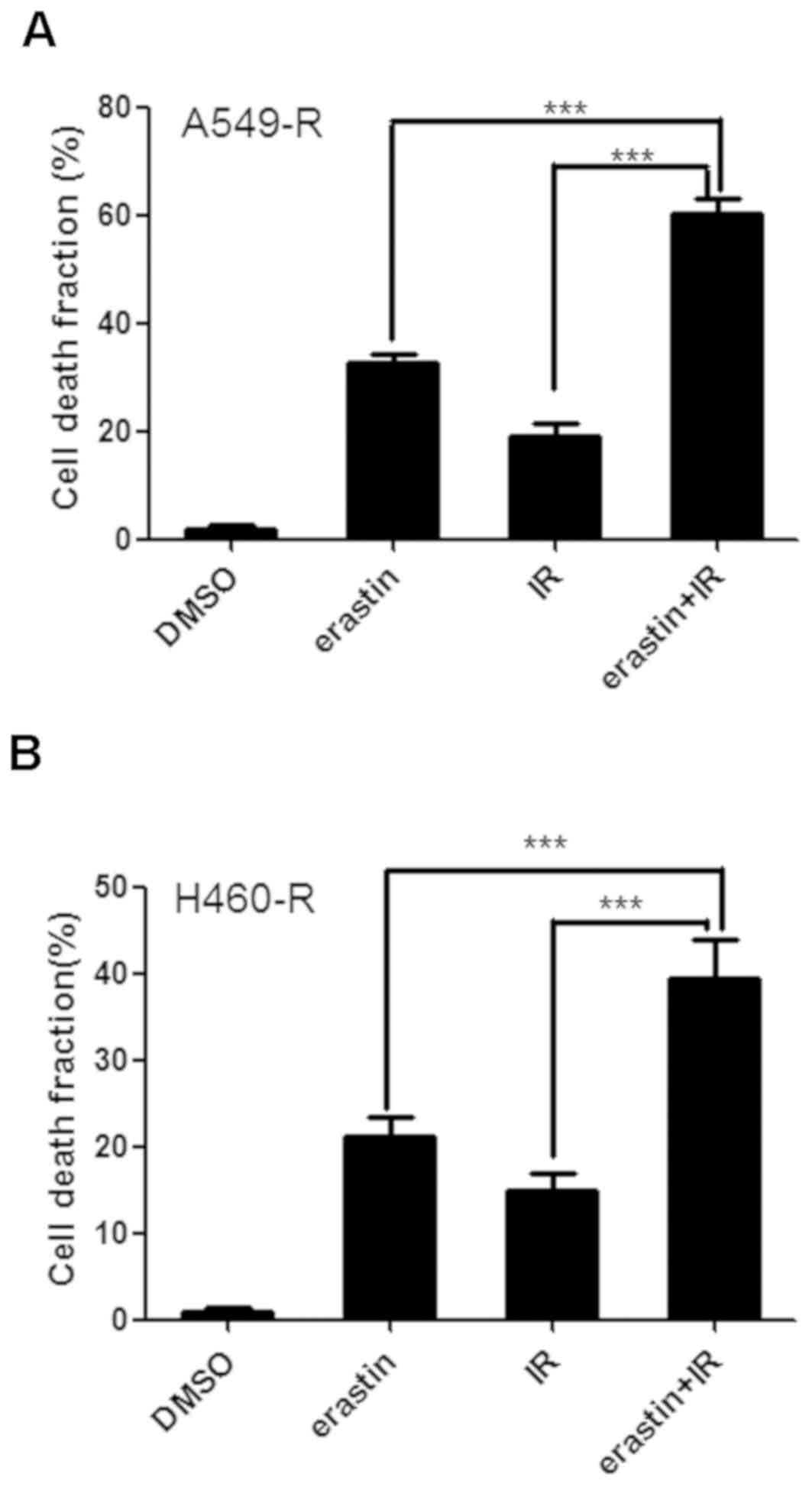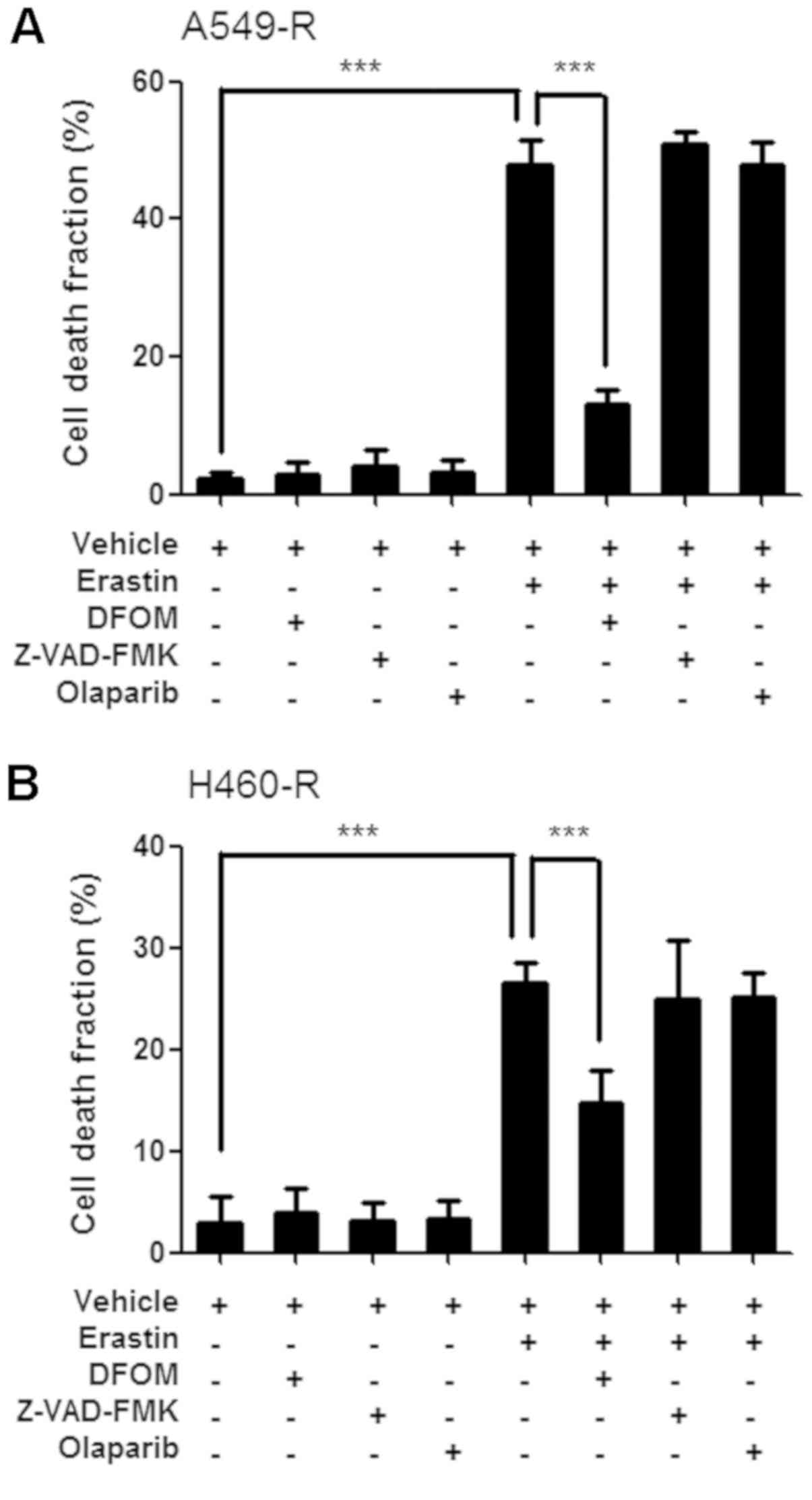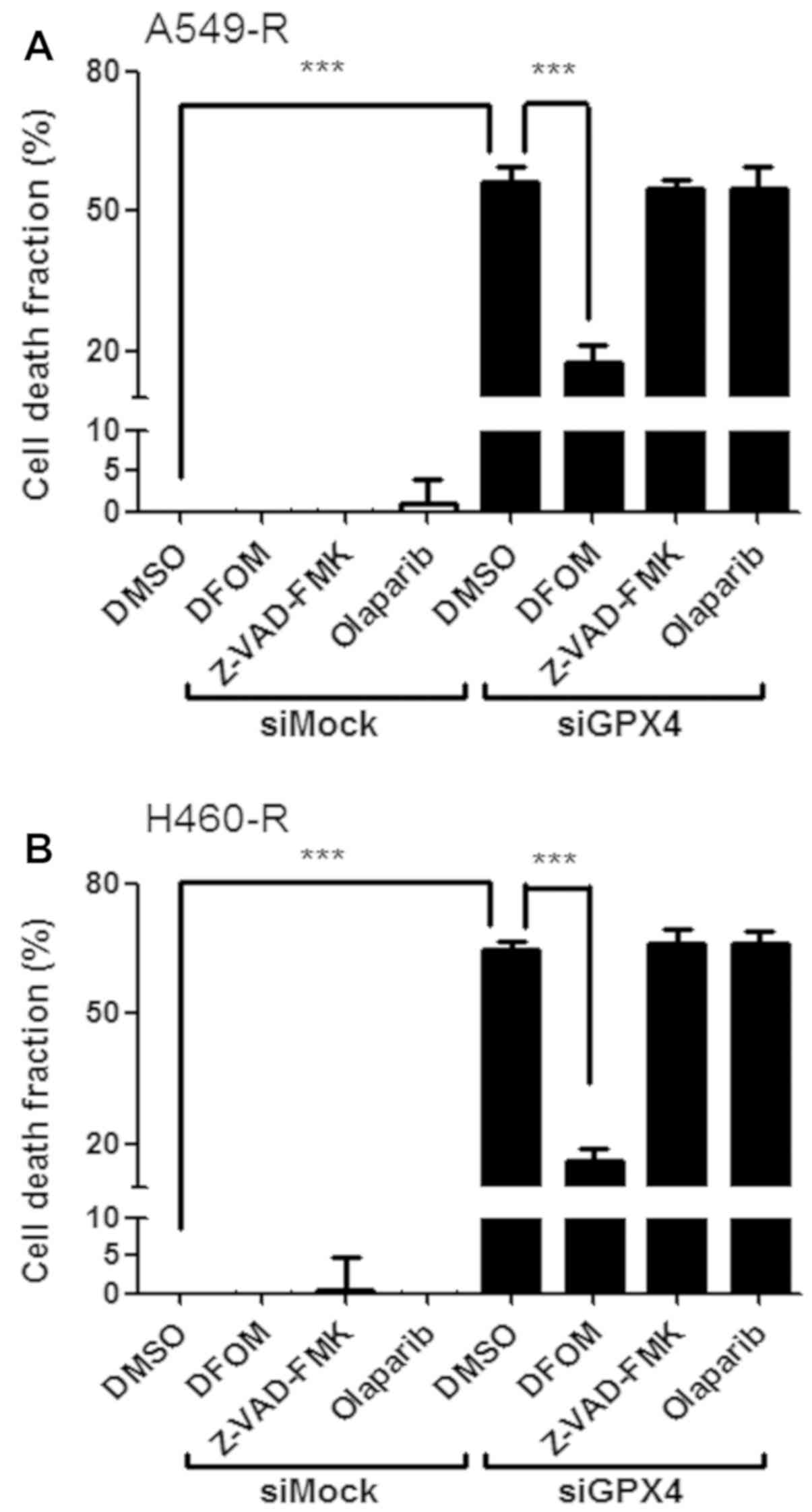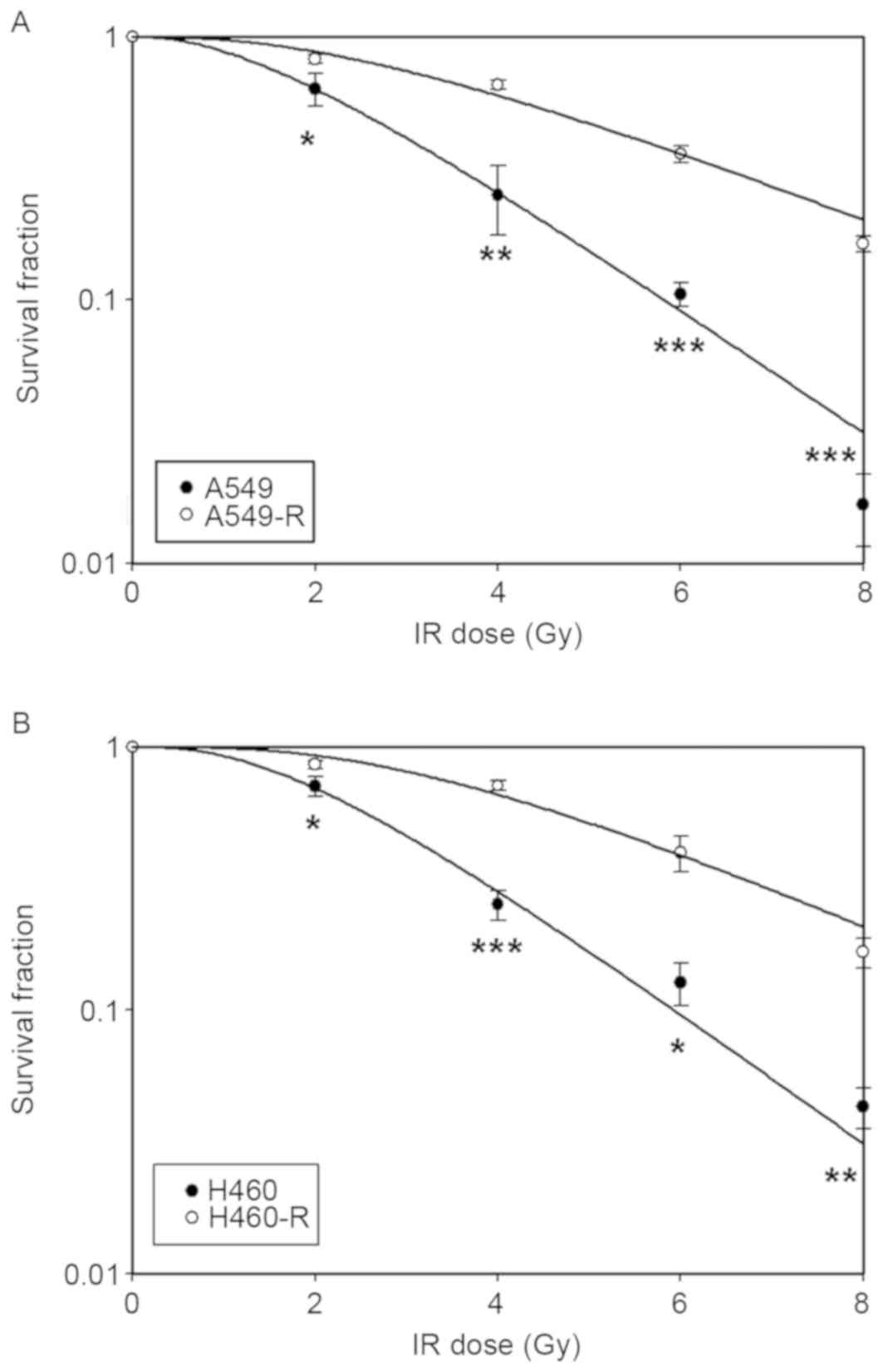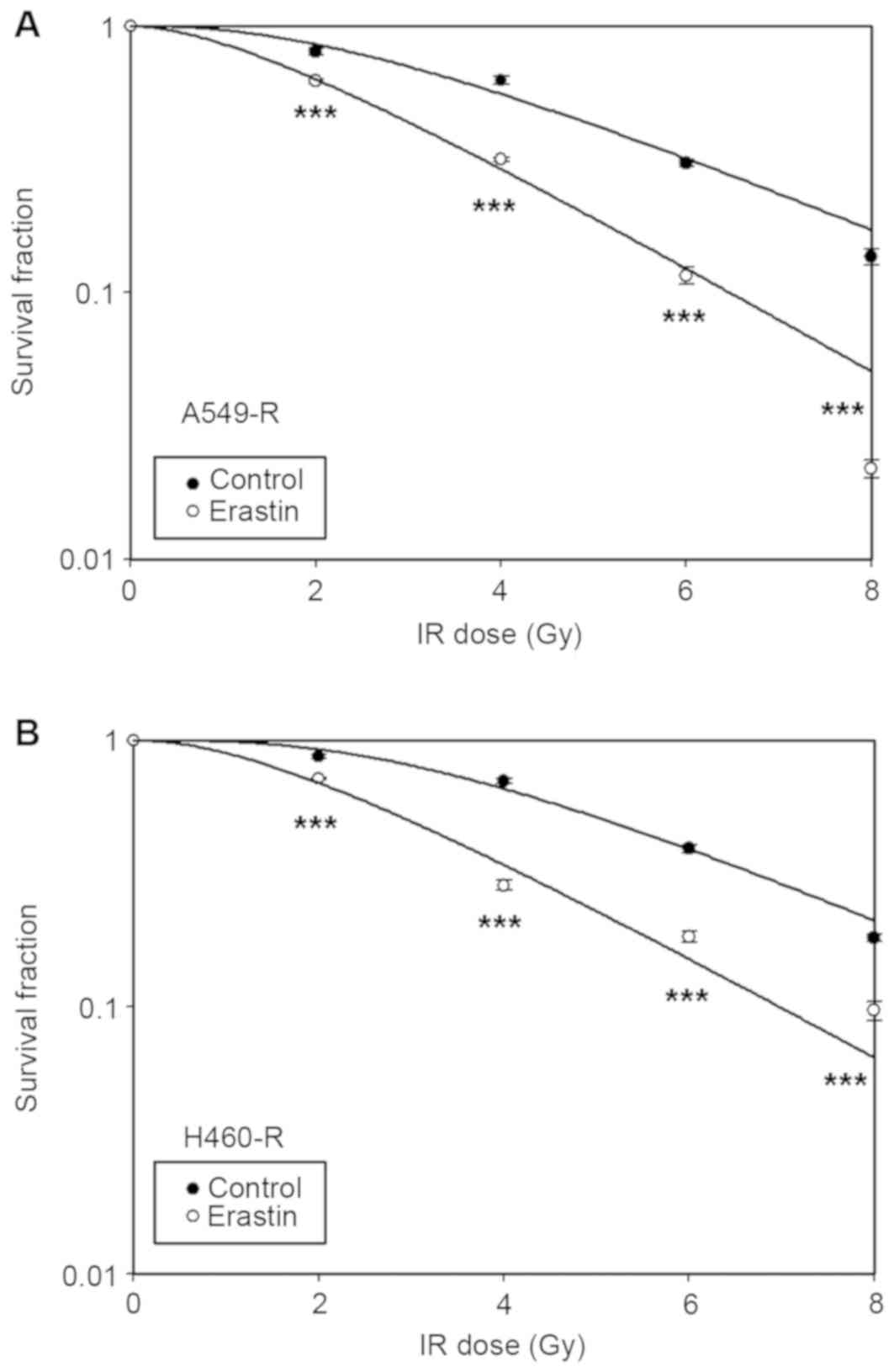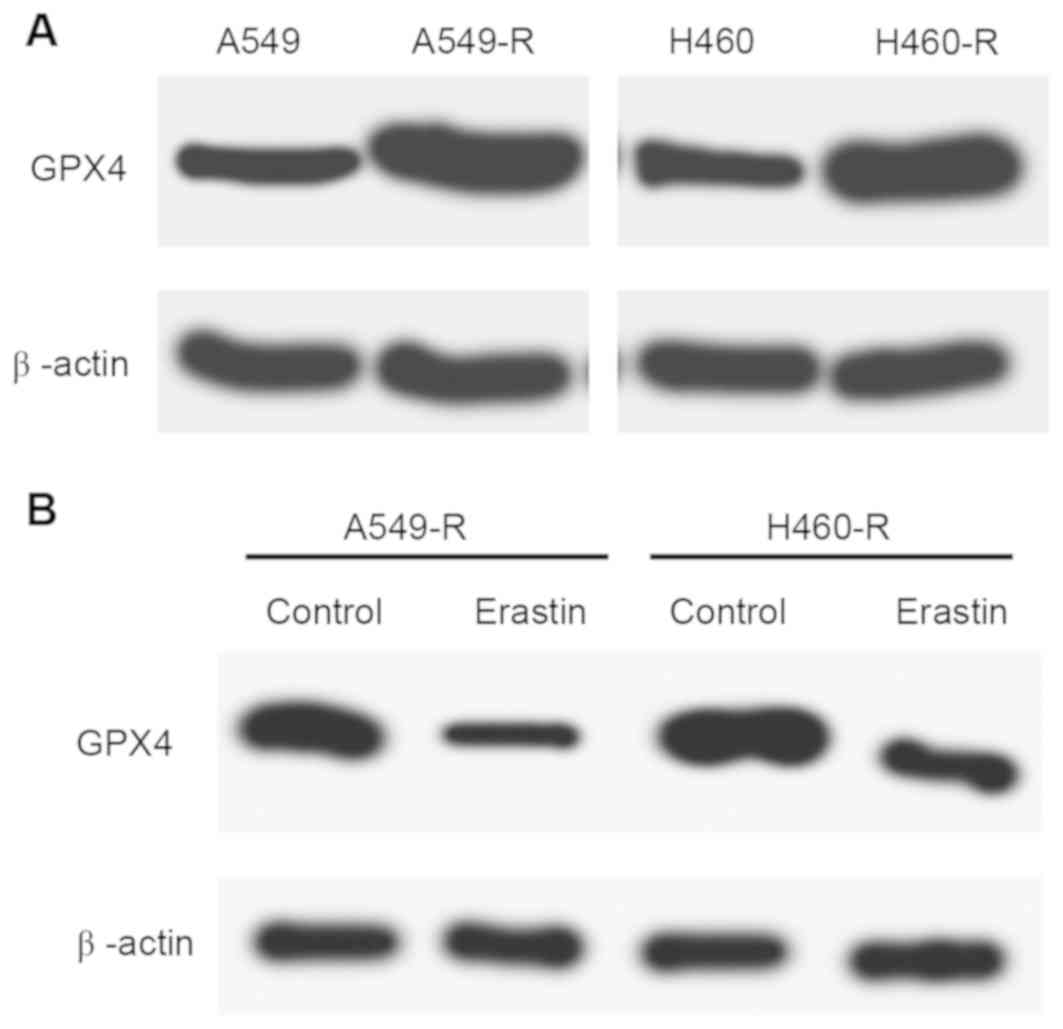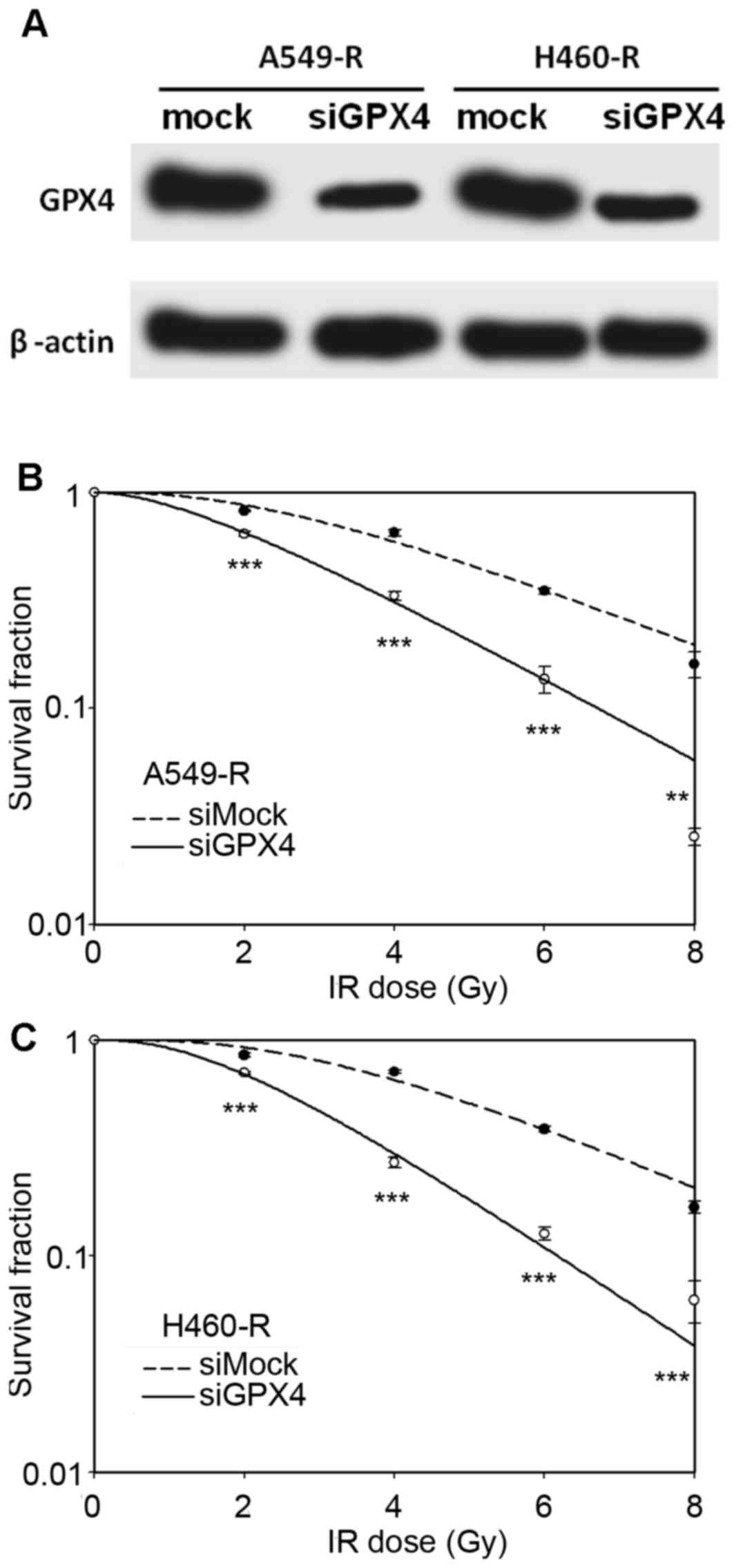Introduction
Lung cancer is one of the most malignant types of
cancer in humans, and according to the 2015 National Institutes of
Health statistics, non-small cell lung cancer (NSCLC) constitutes
~83.9% of lung cancer cases in the USA (1,2).
Radiotherapy is one of the principal therapeutic strategies in the
treatment of lung cancer (3).
However, resistance to radiation results in a poor outcome
following radiotherapy (4,5). Thus, identifying novel methods to avoid
radiation resistance and improve the efficacy of radiotherapy is a
major challenge in the treatment of lung cancer.
Erastin was originally identified when Dolma et
al (6) screened small molecules
that are synthetically lethal in cancer cells expressing RAS
(6,7).
Erastin induces iron-dependent cell death that is morphologically,
biochemically and genetically different from apoptosis, necrosis,
necroptosis and autophagy, and this form of cell death is termed
ferroptosis (8–11). Recently, Yu et al (12) reported that erastin enhances
sensitivity of AML cells to chemotherapy. Another study reported
that the inhibition of ferroptosis increases sorafenib resistance
in hepatocellular carcinoma cells (13). Ivanov et al (14,15)
described that iron-containing water improves the efficiency of
radiotherapy and deferoxamine (DFOM) reduces the efficiency of
radiotherapy in animals with gliomas. These data indicated that
ferroptosis participates in the regulation of response to
chemotherapy and radiotherapy in cancer cells.
According to the Lung Cancer Mutation Consortium
database, oncogenic K-ras mutations were identified in 23% of
patients with lung cancer between 2009–2015 (16). Erastin is a RAS-selective lethal (RSL)
compound, which can trigger ferroptosis (17). Herein, we hypothesized that erastin
may influence radiosensitivity in NSCLC by triggering ferroptosis.
In the present study, two K-ras-expressing NSCLC cell lines (A549
and H460) were selected to conduct the experiments (18,19). The
present study aimed to verify that erastin can decrease, at least
partially, the radioresistance of NSCLC cells and attempted to
perform a preliminary investigation regarding the molecular
mechanism.
Materials and methods
Reagents
The RPMI-1640 culture medium was purchased from
Gibco (Thermo Fisher Scientific, Inc., Waltham, MA, USA). Fetal
bovine serum (FBS) was purchased from Hangzhou Sijiqing Biological
Engineering Materials Co., Ltd (Hangzhou, China). Dimethyl
sulfoxide (DMSO), DFOM, Z-VAD-FMK, trypsin and trypan blue were
purchased from Sigma-Aldrich (Merck KGaA, Darmstadt, Germany).
Primers for glutathione peroxidase 4 (GPX4), small interfering
(si)RNA of GPX4, Lipofectamine® 2000,
TRIzol®, OPTI-MEM I, MMLV reverse transcriptase, Taq DNA
polymerase and Oligo dT primers were purchased from Invitrogen
(Thermo Fisher Scientific, Inc.). Erastin and olaparib were
purchased from Selleck Chemicals (Houston, TX, USA). Protein
molecular weight standards were purchased from Fermentas (Thermo
Fisher Scientific, Inc.). Protein lysis buffer and the
Bicinchoninic Acid (BCA) protein assay kit were purchased from the
Beyotime Institute of Biotechnology (Wuhan, China). Protease
inhibitors were purchased from Roche Diagnostics (Basel,
Switzerland). Rabbit anti-GPX4 (catalog no. ab125066; 1:1,000) and
anti-β-actin (catalog no. ab8226; 1:500) were purchased from Abcam
(Cambridge, MA, USA). Horseradish peroxidase (HRP)-conjugated goat
anti-rabbit secondary antibody (catalog no. TA130023; 1:3,000) was
purchased from OriGene Technologies, Inc. (Beijing, China). All
antibodies were diluted in bovine serum albumin. The Enhanced
Chemiluminescence (ECL) chemiluminescence reagent was purchased
from Thermo Fisher Scientific, Inc.
Cell culture
The human NSCLC cell lines A549 and H460 were
purchased from the American Type Culture Collection (Manassas, VA,
USA). Cells were cultured in RPMI-1640 medium supplemented with 10%
FBS, 100 IU penicillin and 100 µg/ml streptomycin, and incubated at
37°C in a 5% CO2 humidified incubator.
Establishment of the NSCLC
radioresistant subtype cell lines
Exponentially growing NSCLC cells A549 and H460 were
irradiated with 5 does of 6 Gy. Irradiation was performed with 6-MV
X-rays generated by a Siemens Primus H high-energy linear
accelerator (Siemens Healthineers, Erlangen, Germany), as described
previously (20,21). There was a 7–9 day break in between
each irradiation (21). The radiation
field was 10×10 cm, the distance from the source to target was 100
cm and the absorbed dose rate was 0.2 Gy/min. The surviving
sublines (A549-R and H460-R) were then passaged for three months at
37°C and the radiosensitivity was determined by colony formation
assays.
Colony formation assay
A single cell suspension was prepared from the A549,
A549-R, H460 and H460-R cells in their logarithmic growth phase
using 0.25% trypsin for digestion. Cells were seeded in 6-well
plates and received single dose irradiation of 0, 2, 4, 6 and 8 Gy
after a 12 h culture adherence at 37°C in a 5% CO2
humidified incubator. Cell density was 200, 300, 600, 1,200 and
2,400 cells/well for each radiation dose. After 2 weeks, cells were
fixed with 4% paraformaldehyde at 25°C for 20 min and were stained
with Giemsa at 25°C for 15 min. Cell survival fraction (SF) was
calculated based on the following formula: SF=colony numbers in
experimental group/[plating number × plating efficiency (PE)].
PE=(colony numbers in the control group/plating number in control
group) ×100%. A cell survival curve was obtained by the single-hit
multi-target model [SF=l-(1-e−D0/D)N] using
Sigma Plot 10.0 version (Systat Software, Inc, CA, USA). The
parameters of cell survival fraction, a 2 Gy irradiation dose
(survival fraction at 2 Gy irradiation, SF2), mean
lethal dose value (D0), quasithreshold dose
(Dq) and extrapolation number (N) were calculated.
Higher values of SF2, D0 and Dq indicated an
increased radioresistance (22).
Cell death assay
A549-R and H460-R cells were divided into four
groups for the following treatments: i) control group treated with
DMSO; ii) treated with 4 µM erastin alone for 12 h at 37°C; iii)
treated with 2 Gy IR alone and cultured in medium without erastin
for 12 h at 37°C; and iv) treated with 2 Gy IR and then cultured in
medium with 4 µM erastin for 12 h. Following the indicated
treatments, the cells were trypsinized and stained with trypan blue
for 3 min at 25°C, followed by counting with a hemocytometer using
a standard protocol (21). Cells
stained blue were considered as dead cells.
In addition, A549-R and H460-R cells were divided
into eight groups for the following treatments: i) control group;
ii) treated with 100 µM DFOM; iii) treated with 50 µM Z-VAD-FMK;
iv) treated with 10 µM olaparib; v) treated with 4 µM erastin; vi)
treated with 4 µM erastin and 100 µM DFOM; vii) treated with 4 µM
erastin and 50 µM Z-VAD-FMK; and viii) treated with 4 µM erastin
and 10 µM olaparib. All groups were incubated with an equal volume
DMSO, including the control group. The eight groups of cells were
treated for 12 h at 37°C. Following the indicated treatments, the
cells were trypsinized and stained with trypan blue for 3 min at
25°C, followed by counting with a hemocytometer using the standard
protocol (23). Cells stained blue
were considered as dead cells.
Western blotting
A549, A549-R, H460 and H460-R cell lysates were
prepared using the protein lysis buffer, according to the
manufacturer's protocol. Following extraction, protein
concentration was determined with a BCA assay. A total of 30 µg
protein from each sample was loaded into a 10% SDS-PAGE, followed
by a transfer to polyvinylidene fluoride membranes (EMD Millipore,
Billerica, MA, USA). Membranes were blocked with 5% bovine serum
albumin (catalog no. ST023-1000 g; Beyotime Institute of
Biotechnology) for 2 h at 37°C. They were then incubated with
rabbit anti-GPX4 (1:1,000) and anti-β-actin (1:500) antibodies at
4°C overnight. The polyvinylidene fluoride membrane was washed
three times with TBS and Tween-20, 5 min each. Subsequently, the
membranes were incubated with HRP-conjugated goat anti-rabbit
(1:3,000) antibodies for 1 h at 25°C. The ECL reagent then was
added to the membranes and the optical density of the bands was
analyzed using the Image J V1.8.0 software (National Institute of
Health, Bethesda, MD, USA).
siRNA transfection
siGPX4 (catalog no. AM16708) and the control siRNA
(siMock; catalog no. AM4611) were obtained from Invitrogen (Thermo
Fisher Scientific, Inc.). A solution composed of 1 ml OPTI-MEM, 6
µl Lipofectamine 2000 and 2 µl siRNA (the final concentration was 2
µl/ml) was prepared and the mixture (1 ml/well) was incubated in a
6-well dish for 20 min at 37°C. Following incubation, 200,000 cells
were suspended in 1 ml RPMI-1640 culture medium with 20% FBS
(Thermo Fisher Scientific, Inc.). Subsequently, they were
transferred to each well and incubated for 72 h. GPX4 expression
was measured by western blot analysis, as aforementioned.
Statistical analysis
Statistical analysis was performed using SPSS 17.0
(SPSS Inc., Chicago, IL, USA). Data are presented as the mean ±
standard error of the mean. Significant differences between the
groups were determined by unpaired Student's t-test and by one-way
analysis of variance followed by a Bonferroni post hoc test for
multiple group comparisons (Figs. 3,
4 and 7). P<0.05 was considered to indicate a
statistically significant difference.
Results
Radiosensitivity change in A549-R and
H460-R cells
To confirm that the radioresistant cell line was
successfully established, a colony formation assay was performed to
determine the radiosensitivity of A549-R and H460-R cells. The
results demonstrated that A549-R and H460-R cells had increased
survival fractions, compared with A549 and H460 cells,
respectively. Cell survival curves were used to analyze the
results. Therefore, the shoulder area under the survival curve was
increased in H460-R and A549-R cells (Fig. 1). Compared with the A549 and H460
cells, A549-R and H460-R cells, respectively, had increased
D0, Dq, N and SF2 values (Table I), which represented increased
radioresistance. Collectively, these results demonstrated that
radioresistant (A549-R and H460-R) cells were successfully
established.
 | Table I.Parameters of radiosensitivity in
different cell lines. |
Table I.
Parameters of radiosensitivity in
different cell lines.
| Parameter | A549 | A549-R | H460 | H460-R |
|---|
| D0 | 1.84 | 3.12 | 1.74 | 2.81 |
| Dq | 1.50 | 2.17 | 1.70 | 2.40 |
| N | 2.43 | 2.80 | 3.14 | 3.92 |
| SF2 | 0.59 | 0.85 | 0.52 | 0.81 |
Erastin enhances radiosensitivity in
A549-R and H460-R cells
A colony formation assay was performed to
investigate the effect of erastin on radiosensitivity of A549-R and
H460-R cells. The results demonstrated that erastin-treated groups
had reduced survival fractions, compared with the control groups.
Cell survival curves were used to analyze the results.
Additionally, the shoulder area under the survival curves was
reduced in the erastin-treated groups, compared with the control
groups (Fig. 2). Compared with the
control group cells, the erastin group cells had decreased
D0, Dq, N and SF2 values (Table II), which indicated decreased
radioresistance. The result demonstrated that erastin enhances the
sensitivity to radiation therapy in the radioresistant NSCLC
cells.
 | Table II.Parameters of radiosensitivity in
different groups. |
Table II.
Parameters of radiosensitivity in
different groups.
|
| A549-R | H460-R |
|---|
|
|
|
|
|---|
| Parameter | Control | Erastin | Control | Erastin |
|---|
| D0 | 2.97 | 2.21 | 2.85 | 2.28 |
| Dq | 2.08 | 1.45 | 2.39 | 1.61 |
| N | 2.71 | 1.93 | 3.82 | 2.20 |
| SF2 | 0.85 | 0.63 | 0.93 | 0.69 |
Erastin and IR exhibit a combined
effect on killing cells
Following indicated treatment, cell death was
measured. In A549-R cells, cell death fraction induced by erastin +
IR was 60.2±2.7%. The cell death percentage induced by erastin
alone was 32.5±1.9%, while the IR-induced cell death fraction was
19.1±2.5%. In H460-R cells, the cell death fraction in the erastin
+ IR group was significantly increased, compared with the erastin
or IR groups (39.4±4.5% vs. 21.2±2.2% or 14.9±2.1%, respectively)
(Fig. 3). These data revealed that
erastin and IR exhibited a combined effect on killing cells.
Erastin-induced cell death could
partially be rescued by DFOM instead of Z-VAD-FMK and olaparib
DFOM is an iron chelator, which can inhibit
ferroptosis (24). Z-VAD-FMK is a
caspase-inhibitor, which can inhibit caspase-dependent apoptosis
(25). Olaparib is a poly(ADP-ribose)
polymerase 1 (PARP-1) inhibitor that can inhibit PARP-1-dependent
apoptosis (26). Cell death was
detected following treatment with DFOM (100 µM), Z-VAD-FMK (50 µM)
and olaparib (10 µM) alone or with erastin (4 µM) for 12 h at 37°C.
Treatment with erastin induced notable cell death. Treating cells
with DFOM, Z-VAD-FMK and olaparib alone had no notable effect on
cell death. When cells were treated with DFOM and erastin together,
cell death was significantly decreased, compared with treated with
erastin alone. However, when cells were treated with Z-VAD-FMK and
erastin, cell death exhibited no significant difference, compared
with treated with erastin alone. Additionally, olaparib had no
significant effect on erastin-induced cell death (Fig. 4). The results indicated that DFOM
partially rescued erastin-induced cell death, while Z-VAD-FMK and
olaparib had no significant influence on it.
GPX4 expression is increased in the
radioresistant cells and erastin inhibits GPX4 expression in the
radioresistant cells
According to Yang et al (24), one of the mechanisms for erastin to
induce cell death is that erastin inactivates GPX enzymes to
trigger ferroptosis. GPX4 expression was detected in the
radioresistant cells and GPX4 expression level was increased in
A549-R and H460-R cells, compared with A549 and H460 cells,
respectively (Fig. 5A). The
radioresistant cells were treated with erastin and the expression
of GPX4 was detected. The results demonstrated that GPX4 expression
was suppressed by erastin in the A549-R and H460-R cells, compared
with the control groups (Fig. 5B).
Therefore, it was inferred that erastin increases radiosensitivity
in NSCLC cells through inhibiting GPX4.
Knocking down GPX4 expression
radiosensitizes NSCLCs cell to radiation in the radioresistant cell
lines
It was inferred that high levels of GPX4 may
contribute to radioresistance in NSCLC cells. Therefore, siRNA was
used to knockdown GPX4 expression in A549-R and H460-R cells. The
radiosensitivity of the GPX4-knockdown cells (siGPX4) and control
cells (siMock) was subsequently detected with a colony formation
assay and the survival curves were calculated. In A549-R cells,
siGPX4 cells exhibited decreased radioresistance, compared with
siMock cells. In H460-R cells, similar results were achieved,
demonstrating that knocking down the GPX4 expression resulted in
decreased radioresistance (Fig. 6).
The radiosensitivity parameters D0, Dq, N and
SF2 are presented in Table
III. Based on the results, it was concluded that knocking down
the GPX4 expression resulted in decreased radioresistance.
 | Table III.Parameters of radiosensitivity in
different groups. |
Table III.
Parameters of radiosensitivity in
different groups.
|
| A549-R | H460-R |
|---|
|
|
|
|
|---|
| Parameter | siMock | siGPX4 | siMock | siGPX4 |
|---|
| D0 | 3.11 | 2.27 | 2.83 | 1.87 |
| Dq | 2.15 | 1.50 | 2.37 | 1.66 |
| N | 2.77 | 1.97 | 3.78 | 2.83 |
| SF2 | 0.87 | 0.65 | 0.92 | 0.69 |
Cell death induced by the knockdown of
GPX4 could be partially rescued by DFOM, yet not rescued by
Z-VAD-FMK and olaparib
Inhibiting GPX4 expression in A549-R and H460-R
cells induced notable cell death. In A549-R cells, the cell death
fraction was 56.03±3.63% in the siGPX4 group. In H460-R cells, the
cell death fraction was 64.70±1.80% in the siGPX4 group. Treating
siGPX4 group cells with DFOM decreased cell death fraction to
17.5±3.78% in A549-R cells. In H460-R cells, the cell death
fraction was decreased to 16.00±3.05% following treatment with
DFOM. However, treating cells with Z-VAD-FMK and olaparib did not
significantly alter the cell death fraction (Fig. 7). Cell death fractions refer to the
DMSO control. Collectively, these results indicated that the
knockdown GPX4 decreases radioresistance in NSCLC cells by inducing
ferroptosis.
Discussion
Erastin is a type of RSL, which can activate a
lethal pathway that differs from other forms of cell death, such as
apoptosis (6,7). Erastin-induced cell death exhibits
unique morphological, biochemical and genetic features, and the
term ferroptosis was proposed to describe this type of cell death
(8). Iron chelators, including DFOM,
can decrease the iron uptake of cells and inhibit ferroptosis
(9,10,27).
However, apoptotic inhibitors, including Z-VAD-FMK, a caspase
inhibitor, and olaparib, a PARP inhibitor, have no effect on
ferroptosis (12,28).
Ferroptosis is a form of cell death that is
morphologically, biochemically and genetically different from
apoptosis, necrosis and autophagy. Ferroptosis has previously been
observed in RSL-treated cells (8–10). The
classic characteristics of apoptosis include mitochondrial
cytochrome c release, caspase activation and chromatin
fragmentation, which are absent in RSL-induced cell death (7,8). However,
increased levels of intracellular reactive oxygen species is
commonly observed in RSL-treated cells (9,10).
Additionally, RSL-induced cell death can be prevented by iron
chelation or the suppression of iron uptake (7,8,24,29).
Ferroptosis can be activated by small activators in Ras-expressing
cancer cells (6,7,24).
Therefore, the Ras-expressing A549 and H460 cells were selected for
use in the present study. Firstly, radioresistant NSCLC cells were
established (A549-R and H460-R). Subsequently, erastin was used to
treat A549-R and H460-R cells. Treatment with erastin increased the
sensitivity to radiation in A549-R and H460-R cells. Erastin and IR
exhibited a combined effect on inducing cell death. DFOM partially
rescued cell death induced by erastin while Z-VAD-FMK and olaparib
had no notable effect on erastin-induced cell death. Collectively,
the results indicated that erastin increased radiosensitivity in
NSCLC by inducing ferroptosis, at least partially.
GPX4 expression has been demonstrated to be
increased in radioresistant cells and GPX4 is a target molecular of
erastin (24). In the present study,
GPX4 expression was knocked-down in the radioresistant cells, and
decreasing GPX4 expression was observed to significantly induce
cell death. Cell death induced by GPX4-inhibition could be
partially rescued by DFOM, and was not affected by treatment with
Z-VAD-FMK and olaparib. The results indicated that knockdown of
GPX4 induced ferroptosis. The knockdown of GPX4 in the
radioresistance NSCLC cells resulted in increased cell death, which
indicated that GPX4 may be involved in the regulation of
radiosensitivity in NSCLC cells by modulating ferroptosis.
Therefore, we hypothesized that erastin decreases radioresistance
in NSCLC cells partially, by GPX4-mediated ferroptosis.
Ferroptosis has become the focus of an increasing
number of studies. For example, in human hepatocellular carcinoma
cells and other cancer cell lines, sorafenib has been demonstrated
to induce ferroptosis (30,31). Treatment with iron-containing water in
tumor-bearing animals prior to undergoing radiotherapy also
suppressed tumor growth by inducing ferroptosis (14,15). Yu
et al (12) also reported that
ferroptosis induced enhanced sensitivity of acute myeloid leukemia
cells to chemotherapy. In the present study, similar results were
obtained by demonstrating that erastin radiosensitized NSCLC cells
by inducing ferroptosis. These studies demonstrated that
ferroptosis may participate in regulating sensitivity to
chemotherapy and radiotherapy in different types of tumors.
The mechanism of ferroptosis has not been completely
elucidated. However, GPX4 has demonstrated to be an essential in
ferroptosis (24). One basic function
of GPX4 is reducing the peroxides by consuming glutathione (GSH)
(32). In 2008, Seiler et al
(33) reported that a non-apoptotic
form of cell death could be induced by deleting GPX4, and this form
of cell death was mediated by lipid oxidation. In 2012, another
study demonstrated that inhibiting the cystine/glutamate
antiporter, system XC−, would elicit a novel form of
cell death. System XC-is a transporter that provides cells with
cysteine, which is an important material for GSH biosynthesis
(8). GPX4 is the most important
GSH-dependent enzyme in inducing this form of cell death (24). They named this novel form of cell
death ferroptosis (10,24). Although Kagan et al (34) demonstrated that one of the earliest
events following GPX4 deletion is cardiolipin oxidation and
phospholipid oxidation, the downstream mechanisms following GPX4
deletion remain largely unknown, and this mechanisms requires
further study.
The present study, when taken in conjunction with
the previous research, provides evidence of the therapeutic
possibility of triggering ferroptosis in cancer cells. However,
further research is required to understand more about ferroptosis,
before it can be used as a cancer therapeutic in a clinical
setting.
Acknowledgements
The authors would like to thank Professor Gang Wu
and Professor Gang Peng for their advice and suggestions during the
experiments.
Funding
The present study was supported by the Affiliated
Hospital of Guangdong Medical College (grant no.
2017031795/1814).
Availability of data and materials
All data generated or analyzed during this study are
included in this published article.
Authors' contributions
XP performed the colony formation assays and cell
death assays. DJ established the radioresistant cell lines and
performed the western blot analysis. YY and DY cultured the cells
and participated in revising the manuscript. HZ and DZ analyzed the
data. GP, ZC and ZY designed and instructed the study. SL, ZL and
XP contributed to writing and revising the manuscript. GP gave
final approval of the version to be published. All authors read and
approved the final manuscript.
Ethics approval and consent to
participate
Not applicable.
Patient consent for publication
Not applicable.
Competing interests
The authors declare that they have no competing
interests.
References
|
1
|
Li K, Liu J, Tian M, Gao G, Qi X, Pan Y,
Ruan J, Liu C and Su X: CHMP4C disruption sensitizes the human lung
cancer cells to irradiation. Int J Mol Sci. 17(pii): E182015.
View Article : Google Scholar : PubMed/NCBI
|
|
2
|
Noone AM, Howlader N, Krapcho M, Miller D,
Brest A, Yu M, Ruhl J, Tatalovich Z, Mariotto A, Lewis DR, et al:
SEER cancer statistics review (CSR). 1975-2015, National Cancer
Institute; Bethesda, MD: https://seer.cancer.gov/csr/1975_2015/based on
November 2017 SEER data submission, posted to the SEER web site,
April 2018.
|
|
3
|
Radovic M, Kanesvaran R, Rittmeyer A, Früh
M, Minervini F, Glatzer M and Putora PM: Multidisciplinary
treatment of lung cancer in older patients: A review. J Geriatr
Oncol. Oct 3–2018.(Epub ahead of print). View Article : Google Scholar : PubMed/NCBI
|
|
4
|
Gower A, Wang Y and Giaccone G: Oncogenic
drivers, targeted therapies, and acquired resistance in
non-small-cell lung cancer. J Mol Med (Berl). 92:697–707. 2014.
View Article : Google Scholar : PubMed/NCBI
|
|
5
|
Nguyen KS, Neal JW and Wakelee H: Review
of the current targeted therapies for non-small-cell lung cancer.
World J Clin Oncol. 5:576–587. 2014. View Article : Google Scholar : PubMed/NCBI
|
|
6
|
Dolma S, Lessnick SL, Hahn WC and
Stockwell BR: Identification of genotype-selective antitumor agents
using synthetic lethal chemical screening in engineered human tumor
cells. Cancer Cell. 3:285–296. 2003. View Article : Google Scholar : PubMed/NCBI
|
|
7
|
Yagoda N, von Rechenberg M, Zaganjor E,
Bauer AJ, Yang WS, Fridman DJ, Wolpaw AJ, Smukste I, Peltier JM,
Boniface JJ, et al: RAS-RAF-MEK-dependent oxidative cell death
involving voltage-dependent anion channels. Nature. 447:864–868.
2007. View Article : Google Scholar : PubMed/NCBI
|
|
8
|
Yang WS and Stockwell BR: Synthetic lethal
screening identifies compounds activating iron-dependent,
nonapoptotic cell death in oncogenic-RAS-harboring cancer cells.
Chem Biol. 15:234–245. 2008. View Article : Google Scholar : PubMed/NCBI
|
|
9
|
Dixon SJ and Stockwell BR: The role of
iron and reactive oxygen species in cell death. Nat Chem Biol.
10:9–17. 2014. View Article : Google Scholar : PubMed/NCBI
|
|
10
|
Dixon SJ, Lemberg KM, Lamprecht MR, Skouta
R, Zaitsev EM, Gleason CE, Patel DN, Bauer AJ, Cantley AM, Yang WS,
et al: Ferroptosis: An iron-dependent form of nonapoptotic cell
death. Cell. 149:1060–1072. 2012. View Article : Google Scholar : PubMed/NCBI
|
|
11
|
Wolpaw AJ, Shimada K, Skouta R, Welsch ME,
Akavia UD, Pe'er D, Shaik F, Bulinski JC and Stockwell BR:
Modulatory profiling identifies mechanisms of small
molecule-induced cell death. Proc Natl Acad Sci USA. 108:E771–E780.
2011. View Article : Google Scholar : PubMed/NCBI
|
|
12
|
Yu Y, Xie Y, Cao L, Yang L, Yang M, Lotze
MT, Zeh HJ, Kang R and Tang D: The ferroptosis inducer erastin
enhances sensitivity of acute myeloid leukemia cells to
chemotherapeutic agents. Mol Cell Oncol. 2:e10545492015. View Article : Google Scholar : PubMed/NCBI
|
|
13
|
Sun X, Niu X, Chen R, He W, Chen D, Kang R
and Tang D: Metallothionein-1G facilitates sorafenib resistance
through inhibition of ferroptosis. Hepatology. 64:488–500. 2016.
View Article : Google Scholar : PubMed/NCBI
|
|
14
|
Ivanov SD, Semenov AL, Mikhelson VM,
Kovan'ko EG and Iamshanov VA: Effects of iron ion additional
introduction in radiation therapy of tumor-bearing animals. Radiats
Biol Radioecol. 53:296–303. 2013.PubMed/NCBI
|
|
15
|
Ivanov SD, Semenov AL, Kovan'ko EG and
Yamshanov VA: Effects of iron ions and iron chelation on the
efficiency of experimental radiotherapy of animals with gliomas.
Bull Exp Biol Med. 158:800–803. 2015. View Article : Google Scholar : PubMed/NCBI
|
|
16
|
El Osta BE, Behera M, Kim S, Berry LD,
Sica G, Pillai RN, Owonikoko TK, Kris MG, Johnson BE, Kwiatkowski
DJ, et al: Characteristics and outcomes of patients (pts) with
metastatic KRAS mutant lung adenocarcinomas: Lung Cancer Mutation
Consortium (LCMC) database. J Clin Oncol. 35 (15 Suppl):S90212017.
View Article : Google Scholar
|
|
17
|
Kwon MY, Park E, Lee SJ and Chung SW: Heme
oxygenase-1 accelerates erastin-induced ferroptotic cell death.
Oncotarget. 6:24393–24403. 2015. View Article : Google Scholar : PubMed/NCBI
|
|
18
|
Yu JA, Li H, Meng X, Fullerton DA,
Nemenoff RA, Mitchell JD and Weyant MJ: Group IIa secretory
phospholipase expression correlates with group IIa secretory
phospholipase inhibition-mediated cell death in K-ras mutant lung
cancer cells. J Thorac Cardiovasc Surg. 144:1479–1485. 2012.
View Article : Google Scholar : PubMed/NCBI
|
|
19
|
Vigil D, Cherfils J, Rossman KL and Der
CJ: Ras superfamily GEFs and GAPs: Validated and tractable targets
for cancer therapy? Nat Rev Cancer. 10:842–857. 2010. View Article : Google Scholar : PubMed/NCBI
|
|
20
|
Pearce AG, Segura TM, Rintala AC,
Rintala-Maki ND and Lee H: The generation and characterization of a
radiation-resistant model system to study radioresistance in human
breast cancer cells. Radiat Res. 156:739–750. 2001. View Article : Google Scholar : PubMed/NCBI
|
|
21
|
Peng G, Cao RB, Li YH, Zou ZW, Huang J and
Ding Q: Alterations of cell cycle control proteins SHP1/2, p16,
CDK4 and cyclin D1 in radioresistant nasopharyngeal carcinoma
cells. Mol Med Rep. 10:1709–1716. 2014. View Article : Google Scholar : PubMed/NCBI
|
|
22
|
Hall EJ and Giaccia AJ: Radiobiology for
the radiologist. Section I, Chapter 3. Cell survival curves. 7th.
Wolters Kluwer Health/ Lippincott Williams & Wilkins;
Philadelphia, PA, USA: pp. 2–51. 2012
|
|
23
|
Wu L, Liu YY, Li ZX, Zhao Q, Wang X, Yu Y,
Wang YY, Wang YQ and Luo F: Anti-tumor effects of penfluridol
through dysregulation of cholesterol homeostasis. Asian Pac J
Cancer Prev. 15:489–494. 2014. View Article : Google Scholar : PubMed/NCBI
|
|
24
|
Yang WS, SriRamaratnam R, Welsch ME,
Shimada K, Skouta R, Viswanathan VS, Cheah JH, Clemons PA, Shamji
AF, Clish CB, et al: Regulation of ferroptotic cancer cell death by
GPX4. Cell. 156:317–331. 2014. View Article : Google Scholar : PubMed/NCBI
|
|
25
|
Tor YS, Yazan LS, Foo JB, Wibowo A, Ismail
N, Cheah YK, Abdullah R, Ismail M, Ismail IS and Yeap SK: Induction
of apoptosis in MCF-7 cells via oxidative stress generation,
mitochondria-dependent and caspase-independent pathway by ethyl
acetate extract of dillenia suffruticosa and its chemical profile.
PLoS One. 10:e01274412015. View Article : Google Scholar : PubMed/NCBI
|
|
26
|
Yang KS, Kohler RH, Landon M, Giedt R and
Weissleder R: Single cell resolution in vivo imaging of DNA damage
following PARP inhibition. Sci Rep. 5:101292015. View Article : Google Scholar : PubMed/NCBI
|
|
27
|
Li Y, Pan K, Chen L, Ning JL, Li X, Yang
T, Terrando N, Gu J and Tao G: Deferoxamine regulates
neuroinflammation and iron homeostasis in a mouse model of
postoperative cognitive dysfunction. J Neuroinflammation.
13:2682016. View Article : Google Scholar : PubMed/NCBI
|
|
28
|
Fang S, Yu X, Ding H, Han J and Feng J:
Effects of intracellular iron overload on cell death and
identification of potent cell death inhibitors. Biochem Biophys Res
Commun. 503:297–3029. 2018. View Article : Google Scholar : PubMed/NCBI
|
|
29
|
Jiang L, Kon N, Li T, Wang SJ, Su T,
Hibshoosh H, Baer R and Gu W: Ferroptosis as a p53-mediated
activity during tumour suppression. Nature. 520:57–62. 2015.
View Article : Google Scholar : PubMed/NCBI
|
|
30
|
Louandre C, Marcq I, Bouhlal H, Lachaier
E, Godin C, Saidak Z, François C, Chatelain D, Debuysscher V,
Barbare JC, et al: The retinoblastoma (Rb) protein regulates
ferroptosis induced by sorafenib in human hepatocellular carcinoma
cells. Cancer Lett. 356:971–977. 2015. View Article : Google Scholar : PubMed/NCBI
|
|
31
|
Lachaier E, Louandre C, Godin C, Saidak Z,
Baert M, Diouf M, Chauffert B and Galmiche A: Sorafenib induces
ferroptosis in human cancer cell lines originating from different
solid tumors. Anticancer Res. 34:6417–6422. 2014.PubMed/NCBI
|
|
32
|
Conrad M and Friedmann Angeli JP:
Glutathione peroxidase 4 (Gpx4) and ferroptosis: What's so special
about it? Mol Cell Oncol. 2:e9950472015. View Article : Google Scholar : PubMed/NCBI
|
|
33
|
Seiler A, Schneider M, Förster H, Roth S,
Wirth EK, Culmsee C, Plesnila N, Kremmer E, Rådmark O, Wurst W, et
al: Glutathione peroxidase 4 senses and translates oxidative stress
into 12/15-lipoxygenase dependent- and AIF-mediated cell death.
Cell Metab. 8:237–248. 2008. View Article : Google Scholar : PubMed/NCBI
|
|
34
|
Kagan VE, Tyurin VA, Jiang J, Tyurina YY,
Ritov VB, Amoscato AA, Osipov AN, Belikova NA, Kapralov AA, Kini V,
et al: Cytochrome c acts as a cardiolipin oxygenase required for
release of proapoptotic factors. Nat Chem Biol. 1:223–232. 2005.
View Article : Google Scholar : PubMed/NCBI
|















